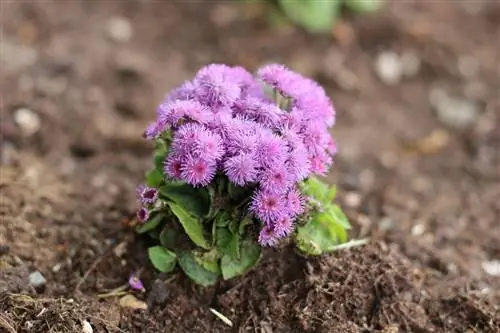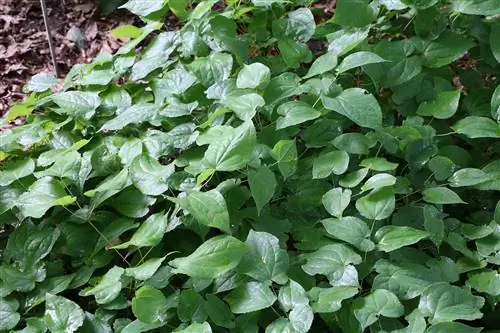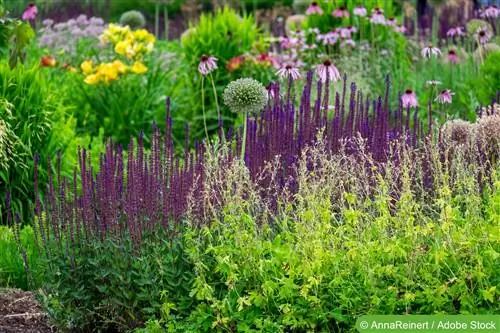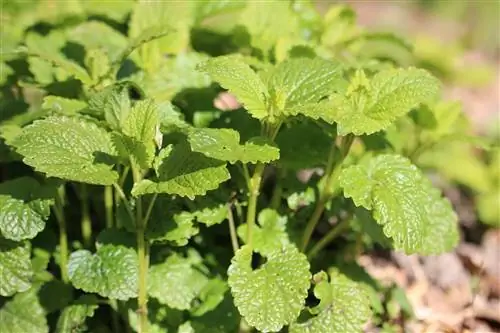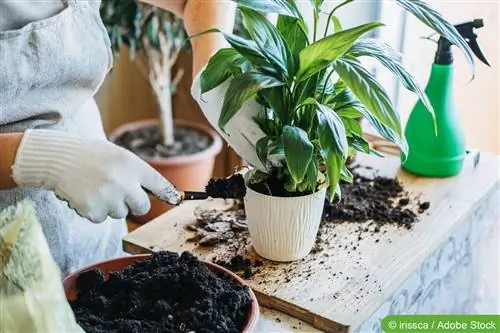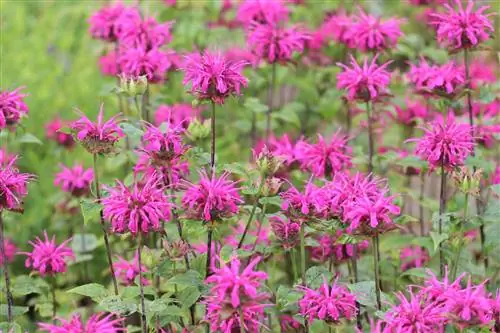- Author admin [email protected].
- Public 2023-12-17 03:39.
- Last modified 2025-06-01 06:48.
Liver balsam is a popular plant for beds and balcony boxes. There are a few points to consider when caring for this beautiful, long-flowering plant. Balanced watering of the plants is particularly important.
Profile
- Botanical name: Ageratum houstonianum
- Plant family: Daisy family (Asteraceae)
- Origin: Mexico, Guatemala, Belize, tropical regions in the south of the USA
- Growth height: 15 - 20 cm
- Growth habit: shrub-like, forms cushions
- Flower colors: white, pink, blue
- Flowering period: May - October
- Flower shape: dense, in clusters
- Leaf shape: egg-shaped
Location
Although liver balm comes from warm regions, it prefers sunny to semi-shady locations. The plants do not like extreme heat. Despite frequent watering, the plants in such locations let their leaves droop to protect themselves when it is very hot. The formation of flowers also suffers from this stress.
Tip:
On a south-facing balcony, you should shade the plants during the peak midday heat.
It shouldn't be too shady for the plants either. Although Ageratum also grows in shady locations, it hardly produces any flowers there.
Floor
The plants react sensitively to waterlogging. Although they tolerate slightly clayey soil, if the soil is too dense, you should definitely incorporate drainage into the soil. For example, expanded clay or lava granules are suitable. When growing in a balcony box or pot, a drainage hole for excess water is always required. A commercially available potting soil is ideal as a substrate.

Sowing
The plants are not hardy and will freeze at the first frost. However, they can easily be propagated by sowing, which is why they are often only cultivated as annual plants.
Sowing takes place at the end of February. The seeds need a temperature of around 20°C so that they can germinate. After germination, the plants are placed cooler at around 16°C.
Sowing instructions:
- Fill the seed tray with seed soil
- Distribute seeds evenly
- Just press the seeds
- pour on
- make bright
The seedlings can be transplanted after around four weeks. To do this, use a substrate that contains more nutrients than potting soil, but is not too rich. This would cause the plants to tend to rot. A mixture of one part potting soil and one part potting soil is ideal.
Planting
The liver balm is very sensitive to frost. He is only allowed outside when there is no longer any threat of night frost. This is usually the case in mid to late May. Before the plants are permanently outdoors, they should be hardened off. They slowly get used to the UV light and the temperatures outside.
Start by moving the plants to a shady location during the day. After a few days you can place the liver balm in the sun for a few hours. But make sure that it is not exposed to the greatest midday heat.
Note:
When planting, ensure a distance of at least 25 centimeters. If the plants are planted too densely, they tend to grow too much and produce fewer flowers.
Fertilization
During flowering, Ageratum should be supplied with liquid fertilizer every two weeks. A fertilizer for flowering balcony plants is ideal. Since the plants are popular with bees, it is recommended to use an organic fertilizer. You can also use commercially prepared nettle manure for fertilization.
Instructions for making a manure:
- Roughly chop the nettles
- Fill the bucket 2/3 full with cabbage
- fill with water
- Cover container
- place in partial shade
- stir every two to three days
As soon as the herb has largely decomposed, you can use the manure for watering. Dilute the manure with water in a ratio of 1:10.
Pouring
The liver balm is very sensitive when watered. It needs constantly slightly moist soil. If the plant is too dry, it hardly produces any flowers. If it is too moist, the roots begin to rot and the plant dies.
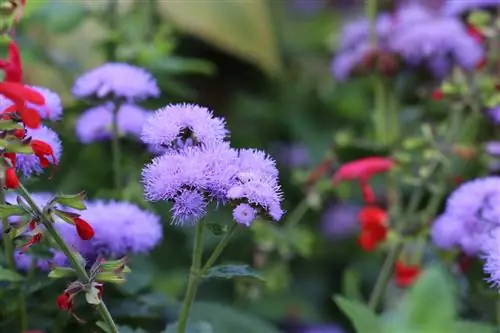
It is important for Ageratum that it is watered regularly, especially during prolonged drought. On very hot summer days it may even require watering several times a day. If the plants are too dry, this can also shorten the duration of flowering.
pruning
Pruning is generally not necessary. You can remove spent inflorescences. However, this only promotes the formation of new flowers to a limited extent. With good care, new flowers quickly cover faded inflorescences.
However, if there are too many faded inflorescences, you can cut the plants back a little more generously. Remove the shoots up to the first leaf axis. This promotes the formation of new shoots that bloom vigorously.
Wintering
The liver balm is not hardy and is usually not overwintered because it is very easy to grow from seeds. If you still want to try to overwinter the plants, cut them back by about a third to a half in the fall. You should transplant bedding plants into large pots in good time.
The winter quarters should have the following properties:
- frost-free
- bright
- Temperature between 10 - 12°C
An unheated, frost-free winter garden, for example, is suitable. In winter the plants are only watered moderately. The substrate may dry out on the surface, but the root ball should always be slightly moist. To check this, simply do the finger test. To do this, drill a finger-deep hole in the soil and check with your finger whether the soil feels moist.
Note:
The liver balm is not fertilized in winter. Only shortly before planting out is the plant brought into the warmth and you can start fertilizing.
Overwintering only helps the plants develop more robust basic shoots. In terms of flower formation, there is hardly any advantage over plants where pre-cultivation was started at the end of February. Occasionally, however, denser shoot formation can also lead to an increased production of flowers, which are very popular with bees.
Diseases
Liver balm is only susceptible toRoot rot Plants in balcony boxes or pots are particularly at risk. If the plants leave their leaves hanging permanently, check the root area. If the roots feel mushy or the soil smells putrid, repot the plants immediately.
Transplanting instructions:
- Completely remove the substrate from the root ball
- Rinse the roots
- removing broken roots
- Clean pot and saucer with hot water
- Fill in drainage made of expanded clay or lava granules
- fill in fresh potting soil
- Plant the plant carefully
Check whether there is still enough root mass so that the plants can continue to grow. If this is not the case, they have little chance of survival and the plants can be disposed of. Water the substrate only moderately and water sparingly in the first week to prevent root rot from progressing. If the substrate is already moist enough, you can skip watering altogether.

Pests
Liver balsam is a popular bedding plant because it is hardly susceptible tosnails. Only very young plants are occasionally eaten by snails; flowering plants are usually no longer attractive to them in the bed.
There are some other pests that can cause problems. These primarily includeAphids. They prefer to settle on weakened plants that have been improperly cared for.
For fertilizing, preferably useStinging nettle manure,which also strengthens the leaf structure and the plants are no longer as attractive to aphids. Amixed culture with lavender or other Mediterranean herbs such as thyme or oregano also quickly drives away the aphids. For a light infestation, you can use a solution of soft soap to simply wash the lice off.
Instructions for making and using a soft soap solution:
- Finely grate 15 g of soft or curd soap
- Dissolve soap in a liter of lukewarm water
- optionally mix in 1 teaspoon of neem oil
- Fill the solution into a spray bottle
- Spraying plants in the evening
- Leaves and shoots should be dripping wet on top and bottom
If the location is too dry, spider mites tend to settle on the liver balm. This problem can be easily combated by spraying the plants with water regularly. Also try to moisten the underside of the leaves. This creates a moist environment in which the spider mites do not feel comfortable.
Tip:
If there is a severe infestation, you can also use the soft soap solution against the spider mites. When spraying, make sure to primarily treat the underside, where the spider mites predominantly reside.

